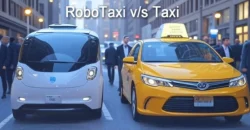The transportation industry in the United States is undergoing a significant transformation with the advent of artificial intelligence (AI) and autonomous vehicle technology, particularly robotaxis. These driverless vehicles, developed by companies like Waymo, Tesla, and Zoox, promise cost-effective and efficient transportation. However, this technological shift raises concerns about the future of taxi driver jobs, including those in the gig economy with platforms like Uber and Lyft. This article examines the current state of taxi driver employment, estimates job losses due to robotaxis as of July 2025 and over the next three years (2026–2028), and explores the broader implications for the workforce. All data and examples are focused on the U.S. context, as requested.
Current Landscape of Taxi Driver Jobs
According to the U.S. Bureau of Labor Statistics (BLS), as of May 2023, approximately 171,100 taxi drivers were employed in the United States under the occupational category SOC 53-3054, which includes both traditional taxi drivers and ride-hailing drivers (e.g., Uber and Lyft). The broader category of taxi drivers, shuttle drivers, and chauffeurs totals 393,400 workers. Taxi driving is an accessible occupation, requiring minimal formal education and offering a median annual wage of $36,220 as of May 2024, significantly above the federal minimum wage.
| Metric | Value |
|---|---|
| Taxi Drivers (SOC 53-3054) | 171,100 (2023) |
| Total (Taxi, Shuttle, Chauffeurs) | 393,400 (2023) |
| Median Annual Wage (Taxi Drivers) | $36,220 (May 2024) |
| Projected Growth (2023–2033) | 11% (faster than average) |
| Annual Job Openings (2023–2033) | 52,100 |
Source: U.S. Bureau of Labor Statistics, Occupational Outlook Handbook
The BLS projects an 11% growth in employment for taxi drivers, shuttle drivers, and chauffeurs from 2023 to 2033, driven by demand for ride-hailing and non-emergency medical transport. However, the rise of robotaxis could temper this growth, particularly for drivers reliant on ride-hailing platforms.
The Rise of Robotaxis
Robotaxis are autonomous vehicles designed to provide ride-hailing services without human drivers, utilizing advanced AI, LIDAR, cameras, and other sensors for navigation. Waymo, a leader in the field, operates approximately 500 vehicles in cities like San Francisco, Los Angeles, Phoenix, and Austin, providing around 200,000 rides per week as of March 2025. Tesla has initiated small-scale robotaxi operations with 20–50 vehicles, and Zoox is launching services in select cities like Las Vegas and San Francisco. The total number of robotaxis in the USA is estimated at around 1,000, a small fraction compared to the 171,100 taxi drivers reported by the BLS in 2023.
The economic appeal of robotaxis lies in their potential to reduce operational costs by eliminating driver-related expenses, which account for a significant portion of traditional taxi fares. A study from George Washington University suggests that robotaxis could decrease frontline jobs by 57% to 76% due to these cost savings. However, challenges such as high initial vehicle costs (e.g., $180,000 per Waymo vehicle in 2021), regulatory hurdles, and public trust issues following incidents like the 2023 Cruise accident in San Francisco may slow adoption.
Current Impact of Robotaxis (2025)
As of July 2025, the impact of robotaxis on taxi driver jobs is minimal due to their limited deployment. Estimates suggest that fewer than 1,000 jobs have been lost nationwide, primarily in cities where robotaxis are operational. In San Francisco, for example, traditional taxi drivers have reported a 20–30% drop in earnings due to competition from cheaper robotaxi services. Currently there is “little evidence” that robotaxis like Waymo One have had a material impact on Uber and Lyft drivers’ earnings in these markets, as human drivers still outnumber autonomous vehicles.
In San Francisco, a robotaxi ride from San Francisco International Airport (SFO) to downtown costs approximately $43, which is less than the traditional taxi fare of around $58. This cost advantage in certain markets indicates that robotaxis can be more affordable, potentially increasing competitive pressure on traditional taxi drivers. However, the overall impact remains localized, affecting only a small fraction of the 171,100 taxi drivers nationwide.
Projected Job Losses (2026–2028)
The expansion of robotaxi fleets could lead to increased job displacement over the next three years. Projections suggest that by 2028, the number of robotaxis in the USA could grow to 10,000, particularly if companies like Waymo, Tesla, and Zoox achieve their expansion goals. If each robotaxi replaces approximately three human drivers (based on their ability to operate longer hours and serve multiple passengers daily), this could affect 15,000–30,000 jobs. However, a more conservative estimate, accounting for regulatory and operational constraints, suggests 5,000–10,000 additional job losses by 2028.
Several factors will influence this trajectory:
- Regulatory Approvals: States like California and Arizona are leading in permitting autonomous vehicle testing, but nationwide adoption requires broader regulatory frameworks. Delays in approvals could limit the scale of job displacement.
- Cost Reductions: Robotaxi rides are currently more expensive than Uber or Lyft, with Waymo rides costing about $5–6 more than ride-hailing services. Costs are expected to decrease as technology improves and economies of scale are achieved.
- Public Acceptance: Safety concerns, such as the reported Tesla robotaxi accident in Las Vegas in April 2024, could slow adoption if public trust wanes.
The BLS projection of an 11% growth in taxi driver employment from 171,100 in 2023 to 193,800 in 2033 suggests that the overall demand for ride-hailing services may offset some job losses. However, the concentration of robotaxi services in urban centers could disproportionately affect drivers in those areas.
| Year | Estimated Robotaxis in USA | Potential Jobs Affected | Notes |
|---|---|---|---|
| 2025 | ~1,000 | <1,000 | Limited deployment, many in testing |
| 2028 | ~10,000 | 5,000–10,000 | Speculative, depends on regulatory and market factors |
Emerging Opportunities and Challenges
While robotaxis threaten traditional taxi driver roles, they are also creating new job opportunities. Roles such as service technicians, remote assistance operators, mapping specialists, and dispatchers are emerging within the autonomous vehicle industry. A Chamber of Progress report estimates that autonomous vehicle deployment could create 114,000–455,000 jobs over the next 15 years in production, maintenance, and related fields. However, these roles often require technical skills, which may not align with the skill sets of current taxi drivers, who have an average age of 48 and lower educational attainment.
| New Job Roles | Skill Requirements | Suitability for Taxi Drivers |
|---|---|---|
| Service Technicians | Technical training, mechanical skills | Low (requires retraining) |
| Remote Assistance Operators | Computer literacy, monitoring skills | Moderate (some retraining) |
| Mapping Specialists | GIS expertise, data analysis | Low (specialized skills) |
| Dispatchers | Communication, logistics management | High (leverages existing skills) |
The George Washington University study emphasizes that labor costs will remain significant in the robotaxi industry due to the need for human intervention in tasks like maintenance and safety oversight. Nevertheless, the net effect is likely to be a reduction in frontline jobs, with a shift toward higher-skilled, better-paid roles that may not be accessible to displaced drivers without retraining.
Societal and Policy Implications
The transition to robotaxis raises critical questions about labor market planning and social safety nets. A RethinkX report underscores the need for governments to prioritize people over industries, advocating for retraining programs, financial support, and healthcare safety nets for displaced workers. Without proactive measures, job losses could exacerbate income inequality, as automation has already contributed to 50–70% of wage declines among blue-collar workers since 1980.
Policymakers could collaborate with robotaxi companies to transition drivers to new roles, such as fleet management or customer service, which leverage existing skills like passenger interaction. Additionally, education systems must prepare future workers for AI-driven roles, emphasizing skills in data analysis, software development, and cybersecurity. Regulatory frameworks, such as those discussed in a RAND report, could use adaptive approaches like Decision Making under Deep Uncertainty (DMDU) to monitor risks and ensure a balanced transition.
Broader Implications for the Transportation Industry
Robotaxis are expected to reshape urban transportation beyond job impacts. They could reduce traffic congestion and carbon emissions, as noted in a Forbes article from March 2025, but may also compete with public transportation systems, as people may opt for cheaper robotaxi rides over buses or trains. Uber and Lyft’s partnerships with companies like Waymo and May Mobility indicate a strategic shift to remain competitive, potentially reducing the direct threat to their drivers by integrating robotaxis into their platforms rather than replacing human drivers entirely.
Conclusion
As of July 2025, the impact of robotaxis on taxi driver jobs in the USA, including Uber and Lyft drivers, is minimal, with fewer than 1,000 jobs lost due to the limited scale of deployment. Over the next three years (2026–2028), an estimated 5,000–10,000 additional jobs may be lost as robotaxi fleets expand to approximately 10,000 vehicles, though this is a rough estimate due to data limitations. The BLS projection of an 11% growth in taxi driver employment suggests that the overall demand for ride-hailing services may offset some losses, and human drivers are expected to coexist with robotaxis in the short term. Regulatory, cost, and safety challenges may further temper the pace of job displacement. As the robotaxi industry evolves, policymakers, companies, and workers must navigate this transition carefully to balance technological innovation with economic stability, ensuring support for displaced drivers through retraining and social safety nets.







